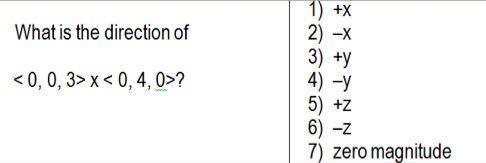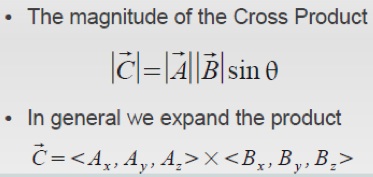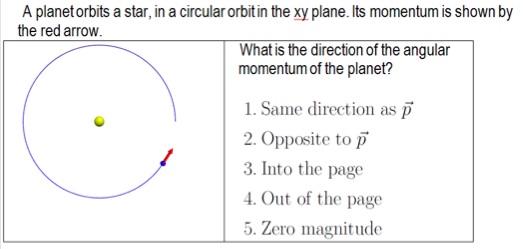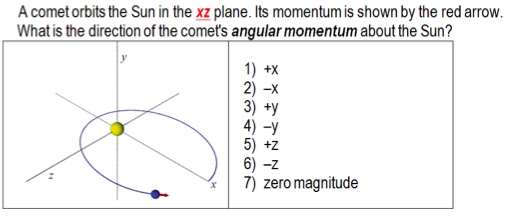Right Hand Rule: Difference between revisions
| Line 10: | Line 10: | ||
===A Mathematical Model=== | ===A Mathematical Model=== | ||
The direction of the angular momentum can also be solved through calculating the cross product of the '''r''' and '''p''' vectors. | The direction of the angular momentum can also be solved through calculating the cross product of the '''r''' and '''p''' vectors. | ||
The cross product of two vectors can be solved as so: | The cross product of two vectors can be solved as so: | ||
[[File:crossproduct2.jpg]] | [[File:crossproduct2.jpg]] | ||
| Line 27: | Line 24: | ||
[[File:problem1.jpg]] | [[File:problem1.jpg]] | ||
Answer | |||
The cross product should be <-12, 0, 0> | |||
So the vector is in the -x direction, which the right hand rule also tells us. | |||
==Examples== | ==Examples== | ||
Revision as of 13:47, 26 November 2015
This topic covers Right Hand Rule. Claimed by: Layla Darian
The Main Idea
The magnitude of the translational angular momentum doesn't tell us everything about the motion of an object. For example, to describe the motion of Earth's orbit if you are standing on the positive z axis looking toward the origin, the Earth is moving counterclockwise in the xy plane. However, this statement cannot be used mathematically. You can't add "counterclockwise in the xy plane" to "clockwise in the yz plane." Instead, we can use the right hand rule to describe the direction of angular momentum as a vector. The direction can be specified like this:
- The plane in which both the position vector from the two objects and the momentum vector for the object of interest lie can be indicated by a unit vector perpendicular to that plane.
- The direction of motion within the plane (clockwise or counterclockwise) can be indicated by establishing a right hand rule (RHR) for this unit vector.
- Right Hand Rule: Using your right arm, point your arm to represent the "r" vector. Now turn your palm in the direction of the momentum vector. Curl your fingers in that direction of the momentum, and extend your thumb outward. The unit vector representing the direction of the angular momentum is defined to point in the direction of your thumb.
- Hint: If the rotational motion is counterclockwise, your right thumb, therefore the unit vector, will point out of the plane. If the rotational motion is clockwise, the unit vector will point into the plane.
A Mathematical Model
The direction of the angular momentum can also be solved through calculating the cross product of the r and p vectors. The cross product of two vectors can be solved as so:
The first row is the standard basis vectors and must appear in the order given here. The second row is the components of r and the third row is the components of p. First, the terms alternate in sign and notice that the 2x2 is missing the column below the standard basis vector that multiplies it as well as the row of standard basis vectors. To solve for the "i" component, you use the expression: bf - ce. Do the same for the "j" and "k" components, and this will give you your vector. Your vector should be <bf-ce, af-cd, ae-bd>.
For more on the explanation of how to calculate cross product, visit this website: [1]
Here is an example problem. Solve first using the right hand rule, and then solve mathematically with the cross product.
 Answer
The cross product should be <-12, 0, 0>
So the vector is in the -x direction, which the right hand rule also tells us.
Answer
The cross product should be <-12, 0, 0>
So the vector is in the -x direction, which the right hand rule also tells us.
Examples
Ans: 4
Ans: 4
Ans: 3
Connectedness
Right Hand Rule is essential for solving all angular momentum problems. Angular Momentum has been my favorite topic so far this semester. I think the problems and situations are very interesting, and they explain the reason behind why a lot of stuff in real life happen that we don't generally think about.
Here are some interesting videos about the conservation of angular momentum:
[[2]]
[[3]]
History
Put this idea in historical context. Give the reader the Who, What, When, Where, and Why.
See also
Once you have learned how to use the Right Hand Rule to determine the direction of angular momentum, you will be able to solve angular momentum and torque problems.
References
All pictures were taken from Professor Flavio Fenton's Physics 2211 lecture notes.




